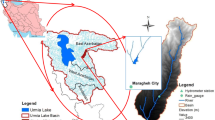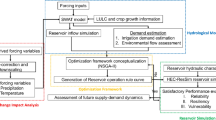Abstract
The water scarcity issue becomes severe due to the decreasing reservoir storage and increasing population. Reservoir deposition is a global issue and a significant concern in water resource management. Despite numerous researchers having previously proposed various desilting strategies specific to sediment transport in reservoirs, there has been limited discussion and presentation of a comprehensive reservoir desilting approach applicable to diverse regions worldwide. This study introduces a 4-stage reservoir life cycle desilting assessment approach, progressively analyzing reservoir management strategies during different life cycles through integrating the 3-R (Reduction-Removal-Release) approach, decision matrix, life cycle evaluation Index, and TGP (Timing-Guiding-Predicting) optimization approach. Considering the representative, the application field chosen for this study is Taiwan reservoirs in Asia. The results demonstrate that the 4-stage assessment method assists in the priority of desilting order for the reservoir management unit and enhances sediment-releasing efficiency during critical periods. Note that the goal of reservoir sustainable development should focus on prolonging their service life, and future efforts should align with various water resource development plans to address water resource crises.






Similar content being viewed by others
References
Adeloye AJ, Soundharajan B-S, Mohammed S (2017) Harmonisation of reliability performance indices for planning and operational evaluation of Water Supply reservoirs. Water Resour Manage 31(3):1013–1029. https://doi.org/10.1007/s11269-016-1561-x
Alexander D (2000) Confronting catastrophe: New perspecitives on natural disasters. (No Title
Asthana BN, Khare D (2022) Reservoir sedimentation. Recent advances in dam engineering. Springer, pp 265–288
Aytac A, Tuna MC, Dogan MS (2023) Development of Upper Euphrates Basin hydro-economic model and hydropower generation optimization. J Water Clim Change 14(9):3385–3397. https://doi.org/10.2166/wcc.2023.377
Aytac A, Dogan MS, Tuna MC (2024) Energy-based hydro-economic modeling of climate change effects on the Upper Euphrates Basin. J Water Clim Change 15(2):733–746. https://doi.org/10.2166/wcc.2024.550
Baky MAA, Islam M, Paul S (2020) Flood hazard, vulnerability and risk assessment for different land use classes using a flow model. Earth Syst Environ 4:225–244
Basson GR (1997) Hydraulic measures to deal with reservoir sedimentation: Flood flushing, sluicing and density current venting. Proceedings of the 3rd International Conference on River Flood Hydraulics, Stellenbosch, South Africa 5–7
Beça P, Rodrigues AC, Nunes JP, Diogo P, Mujtaba B (2023) Optimizing Reservoir Water Management in a changing climate. Water Resour Manage 37(9):3423–3437. https://doi.org/10.1007/s11269-023-03508-x
Boes R, Müller-Hagmann M, Albayrak I (2019) Design, operation and morphological effects of bypass tunnels as a sediment routing technique. Proceedings of the 3rd International Workshop on Sediment Bypass Tunnels 40–50
Brandt SA (2000) A review of reservoir desiltation. Int J Sedim Res, 15(3), Article 3.
Chang MJ, Lin GF, Chen PA, Lee FZ, Lai JS (2020) Development of a real-time forecasting model for turbidity current arrival time to improve reservoir desilting operation. Hydrol Sci J 65(6):1022–1035
Chang H-S, Lin Z-H, Hsu Y-Y (2021) Planning for green infrastructure and mapping synergies and trade-offs: a case study in the Yanshuei River Basin, Taiwan. Urban Forestry Urban Green 65:127325. https://doi.org/10.1016/j.ufug.2021.127325
Chen C-S, Chen Y-L (2003) The rainfall characteristics of Taiwan. Mon Weather Rev, 131(7), Article 7.
Chen T-L, Lin Z-H (2021) Planning for climate change: evaluating the changing patterns of flood vulnerability in a case study in New Taipei City, Taiwan. Stoch Env Res Risk Assess 35(6) Article 6. https://doi.org/10.1007/s00477-020-01890-1
Chen C-S, Chen Y-L, Liu C-L, Lin P-L, Chen W-C (2007) Statistics of heavy rainfall occurrences in Taiwan. Weather Forecast, 22(5), Article 5
Chen Y-J, Lin H-J, Liou J-J, Cheng C-T, Chen Y-M (2022) Assessment of Flood Risk Map under Climate Change RCP8.5 scenarios in Taiwan. Water 14(2). https://doi.org/10.3390/w14020207
ÇIMEN M (2008) Estimation of daily suspended sediments using support vector machines. Hydrol Sci J 53(3):656–666. https://doi.org/10.1623/hysj.53.3.656
Crowder BM (1987) Economic costs of reservoir sedimentation: a regional approach to estimating cropland erosion damage. J Soil Water Conserv, 42(3), Article 3.
De Bruijn KM, Klijn F (2009) Risky places in the Netherlands: a first approximation for floods. J Flood Risk Manag, 2(1), Article 1
Dendy FM, Champion WA, Wilson RB (1973) Reservoir sedimentation surveys in the United States. Wash DC Am Geophys Union Geophys Monogr Ser 17:349–357
Efraimidou E, Spiliotis M (2024) A GIS-Based Flood Risk Assessment using the Decision-Making Trial and Evaluation Laboratory Approach at a Regional Scale. Environ Processes 11(1):9. https://doi.org/10.1007/s40710-024-00683-w
Eini M, Kaboli HS, Rashidian M, Hedayat H (2020) Hazard and vulnerability in urban flood risk mapping: machine learning techniques and considering the role of urban districts. Int J Disaster Risk Reduct 50:101687
Fang H-T, Jhong B-C, Tan Y-C, Ke K-Y, Chuang M-H (2019) A two-stage Approach integrating SOM- and MOGA-SVM-Based algorithms to Forecast spatial-temporal Groundwater Level with Meteorological factors. Water Resour Manage 33(2):797–818. https://doi.org/10.1007/s11269-018-2143-x
Gogus M, Yalcinkaya F (1992) Reservoir sedimentation in Turkey. 5th International Symposium on River Sedimentation. Karlsruhe: University of Karlsruhe 909–918
Huang C-S, Chen M-M, Hsu M-I (2002) A preliminary report on the Chiufenershan landslide triggered by the 921 Chichi earthquake in Nantou, central Taiwan. Terr Atmospheric Ocean Sci, 13(3), Article 3.
Huang C-C, Lai J-S, Lee F-Z, Tan Y-C (2018) Physical model-based investigation of reservoir sedimentation processes. Water, 10(4), Article 4.
Huang C-C, Fang H-T, Ho H-C, Jhong B-C (2019) Interdisciplinary application of numerical and machine-learning-based models to predict half-hourly suspended sediment concentrations during typhoons. J Hydrol 573:661–675
Huang CC, Chang MJ, Lin GF, Wu MC, Wang PH (2021) Real-time forecasting of suspended sediment concentrations in reservoirs by the optimal integration of multiple machine learning techniques. J Hydrology: Reg Stud 34:100804
Hung C-C, Lai J-S, Huang C-C (2022) An efficient and economic desilitation strategy for reservoir sustainable development under the threat of extreme flooding threaten. J Water Clim Change, 13(3), Article 3.
Jhong B-C, Wang J-H, Lin G-F (2016) Improving the long lead-time inundation forecasts using effective typhoon characteristics. Water Resour Manage 30(12):4247–4271. https://doi.org/10.1007/s11269-016-1418-3
Jiang N, Fu L (1998) Problems of reservoir sedimentation in China. Chin Geogra Sci 8:117–125
Kisi O, Dailr AH, Cimen M, Shiri J (2012) Suspended sediment modeling using genetic programming and soft computing techniques. J Hydrol 450–451:48–58. https://doi.org/10.1016/j.jhydrol.2012.05.031
Kondolf GM, Gao Y, Annandale GW, Morris GL, Jiang E, Zhang J, Cao Y, Carling P, Fu K, Guo Q, Hotchkiss R, Peteuil C, Sumi T, Wang H-W, Wang Z, Wei Z, Wu B, Wu C, Yang CT (2014) Sustainable sediment management in reservoirs and regulated rivers: experiences from five continents. Earth’s Future 2(5):Article5. https://doi.org/10.1002/2013EF000184
Kron W (2002) Keynote lecture: Flood risk = hazard× exposure× vulnerability. Flood Def, 82–97
Lahlou A (1996) Environmental and socio-economic impacts of erosion and sedimentation in North Africa. IAHS Publications-Series Proc Reports-Intern Assoc Hydrol Sci 236:491–500
Lechowska E (2018) What determines flood risk perception? A review of factors of flood risk perception and relations between its basic elements. Nat Hazards 94(3). https://doi.org/10.1007/s11069-018-3480-z
Lee F-Z, Sumi T, Lai J-S, Tan Y-C, Huang C-C (2012) Sustainable countermeasures using frequency analysis and desiltation strategy in a reservoir. IAHR-APD One of, 35
Lee F-Z, Lai J-S, Sumi T (2022) Reservoir sediment management and downstream river impacts for sustainable water resources—Case study of shihmen reservoir. Water, 14(3), Article 3.
Lehner B, Liermann CR, Revenga C, Vörösmarty C, Fekete B, Crouzet P, Döll P, Endejan M, Frenken K, Magome J (2011) Global reservoir and dam (grand) database. Tech Doc Version 1:1–14
Li T, Pasternack GB (2022) Water transfer redistributes sediment in Small Mountain reservoirs. Water Resour Manage 36(13):5033–5048. https://doi.org/10.1007/s11269-022-03290-2
Lin G-F, Jhong B-C, Chang C-C (2013) Development of an effective data-driven model for hourly typhoon rainfall forecasting. J Hydrol 495:52–63. https://doi.org/10.1016/j.jhydrol.2013.04.050
Mahmood K (1987) Reservoir sedimentation: impact, extent, and mitigation. Technical paper. International Bank for Reconstruction and Development, Washington, DC (USA)
Molino B, De Vincenzo A, Minó A, Ambrosone L (2023) Long-term Water Management Model for preserving sustainable useful capacity of reservoirs. Water Resour Manage 37(5):1879–1894. https://doi.org/10.1007/s11269-023-03460-w
Obialor C, Okeke O, Onunkwo A, Fagorite V (2019) Reservoir Sedimentation: Causes, Effects and Mitigation. 2488–9849
Ota Y, Chen Y-G, Chen W-S (2005) Review of paleoseismological and active fault studies in Taiwan in the light of the Chichi earthquake of September 21, 1999. Tectonophysics 408(1–4):1–4
Palmieri A, Shah F, Dinar A (2001) Economics of reservoir sedimentation and sustainable management of dams. J Environ Manage 61(2), Article 2.
Palmieri A, Shah F, Annandale GW, Dinar A (2003) Reservoir conservation volume I: the RESCON approach economic and engineering evaluation of alternative strategies for managing sedimentation in storage reservoirs. A Contribution to Promote Conservation of Water Storage Assets Worldwide, The International Bank for Reconstruction and Development/The World Bank, Washington, DC, USA
Schleiss AJ, Franca MJ, Juez C, De Cesare G (2016) Reservoir sedimentation. J Hydraul Res 54(6), Article 6.
Van den Bake W, G. W (1986) Siltation and soil erosion survey in Zimbabwe. IAHS-AISH Publication 159:159
Wisser D, Frolking S, Hagen S, Bierkens MF (2013) Beyond peak reservoir storage? A global estimate of declining water storage capacity in large reservoirs. Water Resour Res, 49(9), Article 9.
Funding
Financial support for this study was provided by a grant from the National Science and Technology Council (project number: 111-2625-M-035-007-MY3.
Author information
Authors and Affiliations
Contributions
Conceptualization, Cheng-Chia Huang; Methodology, Cheng-Chia Huang; Validation, Cheng-Chia, Huang; Writing-Original Draft Preparation, Cheng-Chia, Huang; Supervision, Cheng-Chia Huang.
Corresponding author
Ethics declarations
Ethical Approval
The authors will comply with all academic norms by the journal of Water Resources Management.
Consent to Participate
The author agreed to join this research.
Consent to Publish
The author agreed with the content and that all gave explicit consent to submit.
Competing Interests
There is no conflict of interest.
Additional information
Publisher’s Note
Springer Nature remains neutral with regard to jurisdictional claims in published maps and institutional affiliations.
Rights and permissions
Springer Nature or its licensor (e.g. a society or other partner) holds exclusive rights to this article under a publishing agreement with the author(s) or other rightsholder(s); author self-archiving of the accepted manuscript version of this article is solely governed by the terms of such publishing agreement and applicable law.
About this article
Cite this article
Huang, CC. Navigating Reservoir Deposition Challenges: Evaluation of Reservoir Desilting Strategy Through a 4-Stage Life Cycle Assessment Approach. Water Resour Manage (2024). https://doi.org/10.1007/s11269-024-03847-3
Received:
Accepted:
Published:
DOI: https://doi.org/10.1007/s11269-024-03847-3




